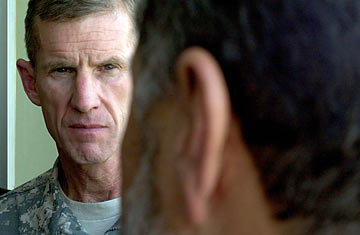
Following the murder of the chief of police and an outbreak of fighting by insurgents in the city's streets, General Stanley McChrystal, newly appointed head of forces in Afghanistan, is briefed by an Afghan National Army commander at a base in Kandahar
(3 of 7)
[Defense Secretary Robert] Gates spoke of your "fresh eyes." What have they shown you?
The first thing I was struck by when I got here was that the security situation is very serious. I am not saying catastrophic, but it is very serious, and it warrants a very serious effort. So that didn't shock me, but it reinforced things that I had been seeing. The other observation is that there has been a tremendous number of people here doing a lot of good work — and that means the ANSF, parts of the Afghanistan government, UNAMA [United Nations Assistance Mission in Afghanistan], NGOs, doing a lot of good work — that said, I don't think it has been as well coordinated and unified as it needs to be successful. And so I wasn't surprised by that, but I was struck by the challenge of the task to pull it all together into a unified international effort. And that to me is an absolute prerequisite for success.
The thing that surprised me about this was the level and energy and passion for this mission that I have seen among so many people involved, right after I was told I was going to be sent here. I started getting e-mails and phone calls from people I knew who wanted to come. And these were people who had been here before. Many away from their families for a long time. One of my aides, who had only six months before come back from a tough assignment in Samarra, Iraq — he volunteered to go. And the energy that I found in that group of people and here in the embassy. It's not what you'd think after eight years. You'd think there would be cynicism, you would think there would be fatigue, but it is actually the opposite — it's a sense of resolve, so I guess the best word I can say is passionate. And that surprised me, and it's been really heartening.
You estimate 18 to 24 months to start seeing progress, but back in D.C., lawmakers want to see results in a year. How do you rectify this?
It's going to take longer than 18 to 24 months to make permanent progress. What I want to see here in stages is, first, if in a fairly limited time we can focus our force on fighting the war that we want to fight, the right kind of counterinsurgency strategy; and second, if we can organize ourselves, in terms of command and control structures, in terms of unity of effort, in terms of all working together. The increase in civilian capacity that is coming in — how we lash that together — I am hoping that we can do that in a matter of months, not years. Then when I sense that we have the team moving in an even better direction than it has ever before, then I think we will start to see progress on the ground.
Your thoughts on the size of the ANSF? What's your estimate on how big it should be?
It's more than we have got right now. I am not going to go out with a number until we finish our strategic assessment, because I want to make sure it fits with all the different parts. Right now the army is authorized to 134 [thousand]. I think that is too small. A country of this size is simply going to have a police-and-army component that is going to have to reach into all areas and also protect their sovereignty. In the near term I think there is less of a threat of conventional things, so I think we are going to have to increase both the army and the police above what is currently allotted.
And U.S. troops?
I am really letting the strategic assessment inform that decision. As much as I can, I am really trying to keep my mind from jumping to conclusions before all the brains we have brought together have done their thing. I think when we look at coin requirements, you can't ignore it, and you can't assume it's wrong, but the coin requirements have never been an absolute cookie cutter. We are using some additional technology here, ISR [Intelligence, Surveillance and Reconnaissance], which gives us a little bit more ability to cover more terrain. And we don't have the insurgency in all parts of the country, so if you go square miles of the number of populace, it's really not at the same levels in most of the country. It's primarily in the south and the east, and then some pockets in the north and west, so if we look at that, we may have different force requirements than 600,000.
